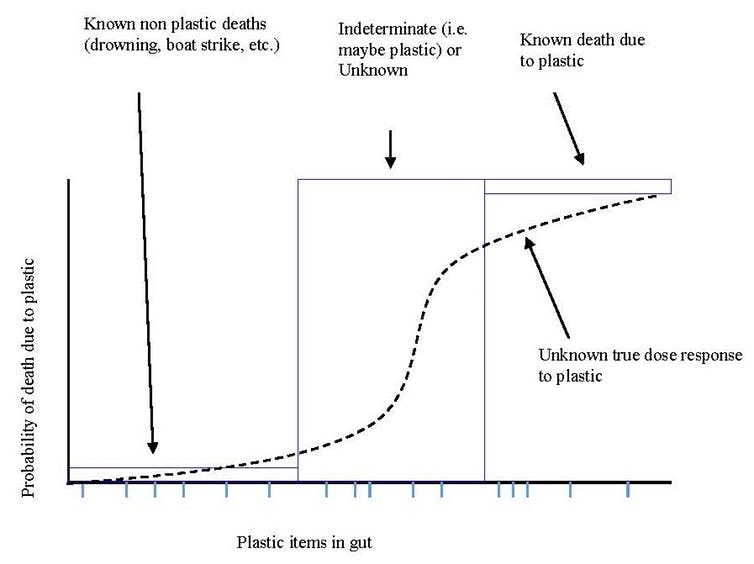
Plastic bags, balloons, and rope fragments were among more than 100 pieces of plastic in the gut of a single turtle. Image: Qamar Schuyler
We know there is a lot of plastic in the ocean, and that turtles (and other endangered species) are eating it. It is not uncommon to find stranded dead turtles with guts full of plastic.
But we weren’t really sure whether plastic eaten by turtles actually kills them, or if they just happen to have plastic inside them when they die. Another way to look at it would be to ask: how much is too much plastic for turtles?
This is a really important question. Just because there’s a lot of plastic in the ocean, we can’t necessarily presume that animals are dying from eating it. Even if a few animals do, that doesn’t mean that every animal that eats plastic is going to die. If we can estimate how much plastic it takes to kill a turtle, we can start to answer the question of exactly how turtle populations are affected by eating plastic debris.
In our research, published today in Nature Scientific Reports, we looked at nearly 1,000 turtles that had died and washed up on beaches around Australia or were found in nets. About 260 of them we examined ourselves; the others were reported to the Queensland Turtle Stranding Database. We carefully investigated why the turtles died, and for the ones we examined, we counted how many pieces of plastic they had eaten.
Some turtles died of causes that were nothing to do with plastic. They may have been killed by a boat strike, or become entangled in fishing lines or derelict nets. Turtles have even been known to die after accidentally eating a blue-ringed octopus. Others definitely died from eating plastic, with the plastic either puncturing or blocking their gut.

One of the first meals eaten by this sea turtle post-hatchling turned out to be deadly. It died from consuming more than 20 tiny pieces of plastic, many of which were about the same size as a grain of rice. Kathy Townsend
Some turtles that were killed by things like boat strikes or fishing nets nevertheless had large amounts of plastic in their guts, despite not having been killed by eating plastic. These turtles allow us to see how much plastic an animal can eat and still be alive and functioning.
The chart below sets out this idea. If an animal drowned in a fishing net, its chance of being killed by plastic is zero – and it falls in the lower left of the graph. If a turtle’s gut was blocked by a plastic bag, its chance of being killed by plastic is 100%, and it’s in the upper right.
The animals that were dead with plastic in their gut, but had other possible causes of death have a chance of death due to plastic somewhere between 0 and 100% – we just don’t know, and they can fall anywhere in the graph. Once we have all the animals in the plot, then we can ask whether we see an increase in the chance of death due to plastic as the amount of plastic in an animal goes up.

Conceptual framework for estimating the probability of death due to plastic debris ingestion. Figure provided by the authors.
Unsurprisingly, we found that the more plastic pieces a turtle had inside it, the more likely it was to have been killed by plastic. We calculated that for an average-sized turtle (about 45cm long), eating 14 plastic items equates to a 50% chance of being fatal.
That’s not to say that a turtle can eat 13 pieces of plastic without harm. Even a single piece can potentially kill a turtle. Two of the turtles we studied had eaten just one piece of plastic, which was enough to kill them. In one case, the gut was punctured, and in the other, the soft plastic had clogged the turtle’s gut. Our analyses suggest that a turtle has a 22% chance of dying if it eats just one piece of plastic.

A green sea turtle that died after consuming 13 pieces of soft plastic and balloons, which blocked its gastrointestinal system. Kathy Townsend
A few other factors also affected the animals’ chance of being killed by plastic. Juveniles eat more debris than adults, and the rate also varies between different turtle species.
Now that we know how much is too much plastic, the next step is to apply this to global estimates of debris ingestion rates by turtles, and figure out just how much of a threat plastic is to endangered sea turtle populations.
This article was originally published on The Conversation. Read the original article here.

